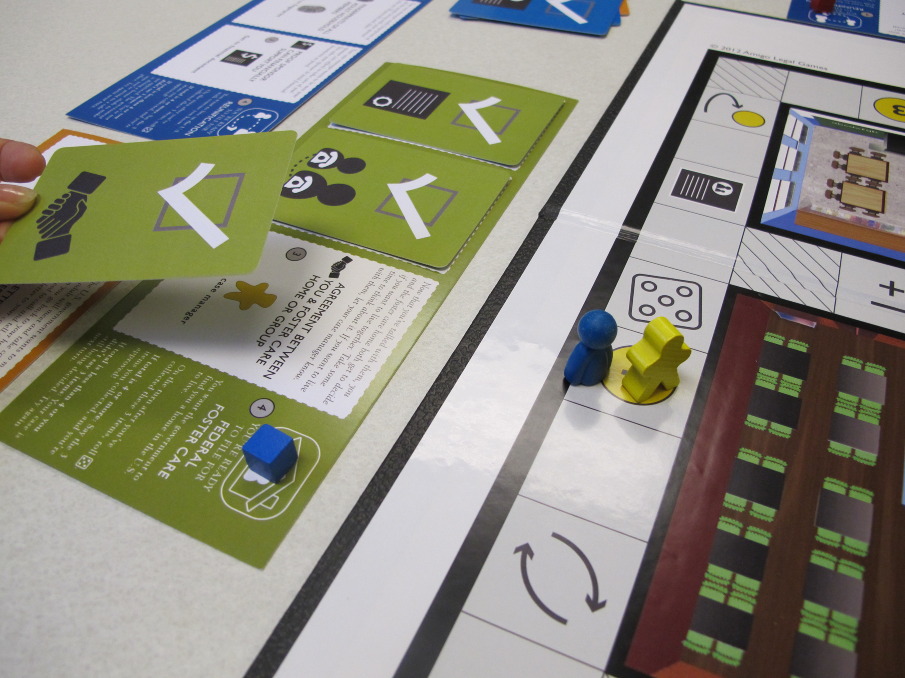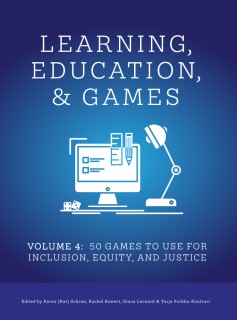Amiguía Americana is primarily addressing the needs and interests of immigrant youth. We have also found that our resources are helpful for non-immigrant youth to play and learn about the immigrant experience in the United States. As such, we have constructed a list of resources to that might help those wanting to use Toma el Paso (Make a Move) (and other educational games) in both informal to formal learning, including college-level classrooms.
Book chapter in “50 Learning Games for Inclusion, Equity, and Justice” (Carnegie Mellon University Press)
Lien Tran (game design professor and Toma el Paso game designer) and Dr. Kate Moran (American Studies professor) co-authored a peer-reviewed book chapter on how to use Toma el Paso (Make a Move) in an learning environment. This chapter is one of 50 total in Learning, Education, and Games, Volume 4: 50 Games to Use for Inclusion, Equity, and Justice, published by Carnegie Mellon University’s ETC Press in January 2024 and edited by Karen Schrier, Rachel Kowert, Diana Leonard, & Tarja Porkka-Kontturi.
This particular volume is aimed at educators, researchers, and designers who want to use games to enhance equity and justice for marginalized students, and create communities where everyone feels like they belong. Each chapter includes:
- Key Details, which provides a quick list of details about the game, including number of players, cost,
developer, genre(s), and the platform(s) to use to play the game; - Summary, which introduces the game and provides an overview of its gameplay;
- How to Use this Game, which relays specific examples of ways to use the game in an educational
setting to foster inclusion, equity, and justice; - Tips & Best Practices, which shares helpful tips, techniques, and strategies for people using or playing the game;
- Related Media & Games, which lists some additional media and games that educators may want to
check out; - Further Reading, which lists some books, articles, and research that educators may want to read to
find out more about the game, or to learn more information about related topics or themes, such as
about using games in an educational context.
You can download for free the digital version of any of the four volumes or purchase physical copies from the Carnegie Mellon University’s ETC Press website.
Using Toma el Paso in an educational context

The Toma el Paso chapter – like all the other chapters in this book – includes “information on the game and how to use it in educational contexts. This information can be used to help decide whether a particular game would work for a learning need or audience, as well as to provide inspiration on how to teach using it.”
Click to download the entire chapter plus all references to Toma el Paso within this 4th volume of the Learning, Education, and Games series.
Note: The original audience for Toma el Paso is unaccompanied and undocumented immigrant minors (UUIM) currently in the care of the U.S. Office of Refugee Resettlement (ORR) and undergoing removal proceedings to learn about the three pathways for release from the current shelter in which they are staying. The game introduces players to key personnel, namely the case manager, and critical items required for each pathway. By playing the game, UUIM gain important information that can reduce confusion about their current situation, which may help them make informed real-world decisions about which pathway to select and what actions, within their control, to take. When played in an educational context, players can take on the perspective of a UUIM applying for shelter release.
The Role of Play in Multimodal Learning on U.S. Immigration
Lien Tran and Dr. Kate Moran were invited to present on “The Role of Play in Multimodal Learning on U.S. Immigration” at Games for Change‘s 2021 festival (held virtually in June 2021). Games for Change is a non-profit that facilitates and recognizes the international creation and distribution of social impact games that serve as critical tools in humanitarian and educational efforts.
Please watch the 8-minute presentation (video below), which highlights unique multimodal learning about immigration in America, including the use of a tabletop game.
Toma el Paso was originally designed for unaccompanied immigrant minors (UIMs) to help navigate the shelter release process when in U.S. government custody. In this presentation, Tran and Moran share strategies for using Toma el Paso in college-level immigration courses, combining student analysis of gameplay with assigned texts and media to enable richer reflection on immigration.
Special thanks to Torrie Hester, Ph.D., and Kate Moran, Ph.D., (Saint Louis University) and Etiony Aldarondo, Ph.D. (Melissa Institute) for your contributions to this list which have been used in courses at Saint Louis University, DePaul University, University of Miami, and beyond.
Related Readings on U.S. Immigration
- “Rising Child Migration to the United States,” migrationpolicy.org, https://www.migrationpolicy.org/programs/us-immigration-policy-program/rising-child-migration-united-states
- Patrisia Macías-Rojas, From Deportation to Prison: The Politics of Immigration Enforcement in Post-Civil Rights America (New York: NYU Press, 2016).
- Rachel Becker Herbst et al., “‘They Were Going to Kill Me’: Resilience in Unaccompanied Immigrant Minors,” The Counseling Psychologist 46, no. 2 (February 1, 2018): 241–68, https://doi.org/10.1177/0011000018759769.
- Etiony Aldarondo and Rachel Becker, “Promoting the Well-Being of Unaccompanied Immigrant Minors,” in Creating Infrastructures for Latino Mental Health, ed. Lydia P. Buki and Lissette M. Piedra (New York, NY: Springer, 2011), 195–214, https://doi.org/10.1007/978-1-4419-9452-3_10.
- Etiony Aldarondo & E. Ameen, “The Immigration Kaleidoscope: Knowing the Immigrant Family Next Door.” in B. Risman (Ed.), Families as They Really Are. (New York, NY: Norton, 2010.)
- Philip E. Wolgin and Angela Maria Kelley, “5 Things You Need to Know About Unaccompanied Children,” Center for American Progress, June 18, 2014, https://www.americanprogress.org/issues/immigration/news/2014/06/18/92056/5-things-you-need-to-know-about-the-unaccompanied-minors-crisis/.
- Collier, L. (2015, March). Helping immigrant children heal: Psychologists are working to help undocumented immigrant children recover from trauma and deal with the uncertainties of their lives. Monitor on Psychology, 46(3). Retrieved from https://www.apa.org/monitor/2015/03/immigrant-children
Related media of U.S. Immigration
- Toma el Paso (Make a Move) game informing on the immigrant youth shelter release process. https://player.vimeo.com/video/143903897?portrait=0
- Latino Americans | Episode 4: The New Latinos. https://www.pbs.org/video/latino-americans-episode-4-new-latinos/
Case Studies and Mentions
- “Play to Learn: Through Collaboration, Students Gain Insight into Immigration System via Game” (Saint Louis University, May 2020) – a case study for immigration (games) in the classroom
- Advocacy through Game Design (DePaul University, August 2022) – interview with Lien Tran and reflection on playing the game by Yessica Pineda, a 2021-22 DePaul HumanitiesX Student Fellow
- Make a Move: Professor’s Board Game Helps Young Immigrants Plot Their Futures (University of Miami, August 2014) – article on training shelter staff in Miami, Florida, on the general system that the youth living in their facility must navigate to be approved for shelter release
- Toma el Paso (Make a Move) featured by Open Law Lab as an interactive and creative way to communicate processes and procedures

